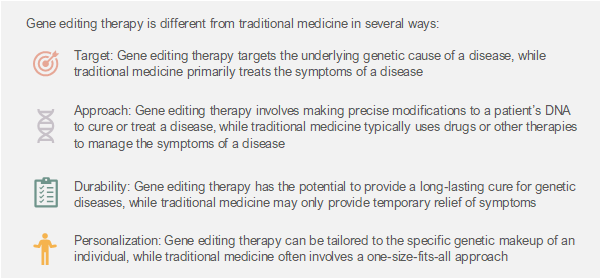Gene editing therapy represents a new frontier in medicine and has the potential to revolutionize the treatment of a variety of diseases and conditions.
While traditional treatments manage symptoms or rely on drugs to target specific biological processes, gene editing offers the potential to treat or cure a wide range of genetic disorders, diseases, and conditions, by making precise and permanent changes to a person’s DNA. This is a major departure from traditional medicine and a truly disruptive approach. Gene editing therapy addresses the underlying genetic causes of disease, which could lead to more effective and long-lasting treatments, and has the potential to significantly improve quality of life for people with a range of conditions. Additionally, gene editing can be done in a precise and targeted manner, which could reduce the likelihood of unwanted side effects.
What is the Origin of Gene Editing Therapy?
The origin of gene editing therapy can be traced back to the discovery of restriction enzymes in the 1970s. Restriction enzymes are molecular scissors that can cut DNA at specific locations, allowing for precise modification of the genetic material. Over the next few decades, various methods were developed to manipulate DNA, including the use of zinc finger nucleases and transcription activator-like effector nucleases (TALENs).
The breakthrough in gene editing therapy came with the discovery of CRISPR-Cas9, a simple and highly efficient system for editing genes. CRISPR-Cas9 works by using a molecule called RNA to guide an enzyme called Cas9 to specific locations in the DNA, where it can make cuts and trigger the cell’s natural repair mechanisms to add, delete, or replace specific genes.
Since the discovery of CRISPR-Cas9, gene editing therapy has rapidly advanced and is now being tested in clinical trials for a wide range of diseases, including sickle cell anemia, cystic fibrosis, and certain types of cancer. While still in the early stages of development, gene editing therapy has the potential to revolutionize the treatment of genetic diseases and has already shown promising results in early studies.
The Gene Editing Therapy Ecosystem
The gene editing therapy ecosystem is a complex and interrelated network of various stakeholders involved in the development, production, and delivery of gene editing therapies. These stakeholders include:
- Gene editing companies are the primary players in the gene editing ecosystem and are responsible for developing and producing gene editing therapies.
- Pharmaceutical companies often partner with gene editing companies to bring their therapies to market and may also invest in the development of gene editing technologies.
- Researchers and academic institutions play a critical role in the development of gene editing therapies by conducting basic and applied research, as well as providing scientific and technical expertise.
- Regulators such as the U.S. Food and Drug Administration (FDA) and the European Medicines Agency (EMA) play a crucial role in ensuring the safety and efficacy of gene editing therapies before they are approved for use.
- Investors such as venture capital firms, hedge funds, and private equity firms provide the funding necessary for the development and commercialization of gene editing therapies.
- Patients and patient advocacy groups play an important role in shaping the direction of the gene editing ecosystem by providing feedback on the development of new therapies and advocating for increased access to treatments.
- Healthcare providers are responsible for administering gene editing therapies to patients and for managing their care and treatment.
This ecosystem is highly interdependent and constantly evolving as new technologies and therapies are developed, regulations change, and market trends shift. The success of the gene editing ecosystem ultimately depends on the collaboration and coordination of these various stakeholders.
Common Market Strategies for Gene Editing Therapy Startups
Gene editing therapy startups typically follow a few key market strategies to bring their products to market:
- Partnering with pharmaceutical companies: Many gene editing startups partner with larger pharmaceutical companies to leverage their resources and expertise in clinical development, regulatory affairs, and commercialization.
- Focusing on specific therapeutic areas: Some gene editing startups focus on specific therapeutic areas, such as genetic disorders or cancer, to build their expertise and differentiate themselves from other companies.
- Developing technology platforms: Many gene editing startups aim to develop proprietary technology platforms that can be applied to multiple therapeutic areas, which can help them to diversify their product pipelines and reduce risk.
- Building clinical pipelines: Gene editing startups typically invest heavily in clinical development to demonstrate the safety and efficacy of their therapies, which is crucial for regulatory approval and commercial success.
- Pursuing multiple development paths: Some gene editing startups pursue multiple development paths, such as in-licensing or acquiring existing programs, to expand their product pipelines and increase their chances of success.
These strategies can help gene editing startups to build strong product pipelines, establish themselves as leaders in the field, and bring their therapies to market effectively. However, the market for gene editing therapies is highly competitive and rapidly evolving, and companies must be nimble and adaptable to succeed in this dynamic environment.
Gene editing has the potential to transform healthcare by allowing precise alterations to the genetic code and correcting genetic mutations that cause diseases. Gene editing therapies have shown promise in treating a wide range of conditions, from genetic disorders to certain cancers. However, gene editing is still a relatively new and rapidly evolving field, and there is much that remains unknown about its long-term effects and safety. Additionally, there are regulatory and ethical considerations that must be taken into account before gene editing therapies can be widely adopted. Despite these challenges, gene editing has the potential to revolutionize the way we treat and cure diseases, making it a promising area of research in the field of healthcare.
Related Market Report
Emersion Insights specialise in strategic market intelligence for investors and innovators. Our “Gene Editing Therapy Market Report” includes a detailed investment analysis of the venture capital and post-IPO funding in the industry so far, measures the current market size by bottom-up revenue analysis, provides a highly segmented market forecast until 2030, and clarifies the challenges and opportunities in this industry in the coming years. Reach out to the report author Dr Ulrik Kristensen for more information: hello@emersioninsights.io





